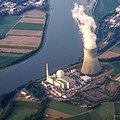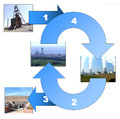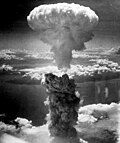Portal:Nuclear technology
The Nuclear Technology Portal
Introduction

- Nuclear technology is technology that involves the nuclear reactions of atomic nuclei. Among the notable nuclear technologies are nuclear reactors, nuclear medicine and nuclear weapons. It is also used, among other things, in smoke detectors and gun sights. (Full article...)
- Nuclear power is the use of nuclear reactions to produce electricity. Nuclear power can be obtained from nuclear fission, nuclear decay and nuclear fusion reactions. Presently, the vast majority of electricity from nuclear power is produced by nuclear fission of uranium and plutonium in nuclear power plants. Nuclear decay processes are used in niche applications such as radioisotope thermoelectric generators in some space probes such as Voyager 2. Reactors producing controlled fusion power have been operated since 1958 but have yet to generate net power and are not expected to be commercially available in the near future. (Full article...)
- A nuclear weapon is an explosive device that derives its destructive force from nuclear reactions, either nuclear fission (fission or atomic bomb) or a combination of fission and nuclear fusion reactions (thermonuclear weapon), producing a nuclear explosion. Both bomb types release large quantities of energy from relatively small amounts of matter. (Full article...)
General images -
Selected article -
Testing began with scale models at the Naval Proving Ground in Dahlgren, Virginia, in August 1943. Modifications began on a prototype Silverplate B-29 known as the "Pullman" in November 1943, and it was used for bomb flight testing at Muroc Army Air Field in California commencing in March 1944. The testing resulted in further modifications to both the bombs and the aircraft.
Seventeen production Silverplate aircraft were ordered in August 1944 to allow the 509th Composite Group to train with the type of aircraft they would fly in combat, and for the 216th Army Air Forces Base Unit to test bomb configurations. These were followed by 28 more aircraft that were ordered in February 1945 for operational use by the 509th Composite Group. This batch included the aircraft which were used in the atomic bombings of Hiroshima and Nagasaki in August 1945. Including the Pullman B-29, 46 Silverplate B-29s were produced during and after World War II. An additional 19 Silverplate B-29s were ordered in July 1945, which were delivered between the end of the war and the end of 1947. Thus, 65 Silverplate B-29s were made. The use of the Silverplate codename was discontinued after the war, but modifications continued under a new codename, Saddletree. Another 80 aircraft were modified under this program. The last group of B-29s was modified in 1953 but never saw further service. (Full article...)
Selected picture -
Attribution: The Ames Laboratory, USDOE (http://www.ameslab.gov/)
Did you know?
- ... that a nuclear reactor was nearly built at the New York Hall of Science, but the money for the institution instead went to Yankee Stadium?
- ... that the British Tychon missile was developed from a Barnes Wallis concept to keep strike aircraft safe while dropping nuclear bombs?
- ... that some years after unknowingly working for the Manhattan Project, Charles Fisk quit physics and became an organ builder?
- ... that 1ES 1927+654, a galaxy in Draco, exhibited such extreme nuclear activity that it challenged conventional models of black-hole environments?
- ... that Project Ketch proposed the detonation of a 24-kiloton nuclear device in Pennsylvania to create a natural-gas storage reservoir?
- ... that Fritz Strassmann, a co-discoverer of nuclear fission, concealed a Jewish woman in his home during World War II?
Related WikiProjects
Things you can do
| Parts of this portal (those related to section) need to be updated. Please help update this portal to reflect recent events or newly available information. Relevant discussion may be found on the talk page. (September 2021) |
|
Here are some Open Tasks :
|
Selected biography -
Farrell graduated from Rensselaer Polytechnic Institute with a degree in civil engineering in 1912. During World War I, he served with the 1st Engineers on the Western Front, and was awarded the Distinguished Service Cross and the French Croix de guerre. After the war, he was an instructor at the Engineer School, and then at the United States Military Academy at West Point. He resigned from the Regular Army in 1926 to become Commissioner of Canals and Waterway for the State of New York from 1926 to 1930, and head of construction and engineering of the New York State Department of Public Works from 1930 until 1941.
During World War II he returned to active duty as Groves' executive officer in the Operations Branch of the Construction Division under the Office of the Quartermaster General. He went to the China-Burma-India theater to help build the Ledo Road. In January 1945, Groves chose Farrell as his second-in-command of the Manhattan Project. Farrell observed the Trinity test at the Alamogordo Bombing and Gunnery Range with J. Robert Oppenheimer. In August 1945, he went to Tinian to supervise the bombing of Hiroshima and Nagasaki. Afterwards he led teams of scientists to inspect the effects of the atomic bombs.
In 1946 he was appointed chairman of the New York City Housing Authority. He subsequently worked as a consultant for the Triborough Bridge and Tunnel Authority on projects such as the Cross Bronx Expressway. He was a member of the evaluation board for Operation Crossroads, and was an advisor to Bernard Baruch, the United States representative on the United Nations Atomic Energy Commission. During the Korean War, Farrell returned to active duty once more, serving with the Defense Production Administration, and then with the Atomic Energy Commission as its Assistant General Manager for Manufacturing. He oversaw a vast increase in the commission's production capabilities before retiring again in 1951. From 1960 to 1964, he worked on the preparations for the 1964 New York World's Fair. (Full article...)
Nuclear technology news
- 1 August 2025 – Russian invasion of Ukraine
- U.S. president Donald Trump orders the deployment of two United States Navy nuclear submarines near Russia for potential military action against Russian forces in response to statements made by former Russian president Dmitry Medvedev and current deputy chairman of the Security Council of the Russian Federation regarding Trump's previously-stated deadline for ending the war in Ukraine. (Reuters) (BBC News)
Related portals
Related topics
Subcategories
Associated Wikimedia
The following Wikimedia Foundation sister projects provide more on this subject:
-
Commons
Free media repository -
Wikibooks
Free textbooks and manuals -
Wikidata
Free knowledge base -
Wikinews
Free-content news -
Wikiquote
Collection of quotations -
Wikisource
Free-content library -
Wikiversity
Free learning tools -
Wiktionary
Dictionary and thesaurus


























































































